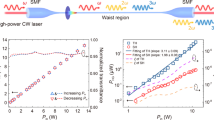Abstract
Silica waveguides with diameters larger than the wavelength of transmitted light are widely used in optical communications, sensors and other applications1,2,3. Minimizing the width of the waveguides is desirable for photonic device applications, but the fabrication of low-loss optical waveguides with subwavelength diameters remains challenging because of strict requirements on surface roughness and diameter uniformity4,5,6,7. Here we report the fabrication of subwavelength-diameter silica ‘wires’ for use as low-loss optical waveguides within the visible to near-infrared spectral range. We use a two-step drawing process to fabricate long free-standing silica wires with diameters down to 50 nm that show surface smoothness at the atomic level together with uniformity of diameter. Light can be launched into these wires by optical evanescent coupling. The wires allow single-mode operation, and have an optical loss of less than 0.1 dB mm-1. We believe that these wires provide promising building blocks for future microphotonic devices with subwavelength-width structures.
This is a preview of subscription content, access via your institution
Access options
Subscribe to this journal
Receive 51 print issues and online access
$199.00 per year
only $3.90 per issue
Buy this article
- Purchase on Springer Link
- Instant access to full article PDF
Prices may be subject to local taxes which are calculated during checkout




Similar content being viewed by others
References
Yamane, M. & Asahara, Y. Glasses for Photonics (Cambridge Univ. Press, Cambridge, UK, 2000)
Murata, H. Handbook of Optical Fibers and Cables 2nd edn (Marcel Dekker, New York, 1996)
Mynbaev, D. K. & Scheiner, L. L. Fiber-Optic Communications Technology (Prentice Hall, New York, 2001)
Marcuse, D. Mode conversion caused by surface imperfections of a dielectric slab waveguide. Bell Syst. Tech. J. 48, 3187–3215 (1969)
Marcuse, D. & Derosier, R. M. Mode conversion caused by diameter changes of a round dielectric waveguide. Bell Syst. Tech. J. 48, 3217–3232 (1969)
Ladouceur, F. Roughness, inhomogeneity, and integrated optics. J. Lightwave Technol. 15, 1020–1025 (1997)
Lee, K. K. et al. Effect of size and roughness on light transmission in a Si/SiO2 waveguide: experiments and model. Appl. Phys. Lett. 77, 1617–1619 (2000). Erratum. Appl. Phys. Lett. 77, 2258 (2000)
Boys, C. V. On the production, properties, and some suggested uses of the finest threads. Phil. Mag. 23, 489–499 (1887)
Threlfall, R. On Laboratory Arts (Macmillan, London, 1898)
Knight, J. C., Cheung, G., Jacques, F. & Birks, T. A. Phase-matched excitation of whispering-gallery-mode resonances by a fiber taper. Opt. Lett. 22, 1129–1131 (1997)
Birks, T. A., Wadsworth, W. J. & Russell, P. St. J. Supercontinuum generation in tapered fibers. Opt. Lett. 25, 1415–1417 (2000)
Cai, M. & Vahala, K. Highly efficient hybrid fiber taper coupled microsphere laser. Opt. Lett. 26, 884–886 (2001)
Kakarantzas, G., Dimmick, T. E., Birks, T. A., Le Roux, R. & Russell, P. St. J. Miniature all-fiber devices based on CO2 laser microstructuring of tapered fibers. Opt. Lett. 26, 1137–1139 (2001)
Dimmick, T. E., Kakarantzas, G., Birks, T. A. & Russell, P. St. J. Carbon dioxide laser fabrication of fused-fiber couplers and tapers. Appl. Opt. 38, 6845–6848 (1999)
Grellier, A. J. C., Zayer, N. K. & Pannell, C. N. Heat transfer modeling in CO2 laser processing of optical fibres. Opt. Commun. 152, 324–328 (1998)
Wang, Z. L., Gao, R. P. P., Gole, J. L. & Stout, J. D. Silica nanotubes and nanofiber arrays. Adv. Mater. 12, 1938–1940 (2000)
Pan, Z. W., Dai, Z. R., Ma, C. & Wang, Z. L. Molten gallium as a catalyst for the large-scale growth of highly aligned silica nanowires. J. Am. Chem. Soc. 124, 1817–1822 (2002)
Hu, J. Q., Meng, X. M., Jiang, Y., Lee, C. S. & Lee, S. T. Fabrication of germanium-filled silica nanotubes and aligned silica nanofibers. Adv. Mater. 15, 70–73 (2003)
Labelle, H. E. & Mlavsky, A. I. Growth of sapphire filaments from melt. Nature 216, 574–575 (1967)
Morales, A. M. & Lieber, C. M. A laser ablation method for the synthesis of crystalline semiconductor nanowires. Science 279, 208–211 (1998)
Xia, Y., Rogers, J. A., Paul, K. E. & Whitesides, G. M. Unconventional methods for fabricating and patterning nanostructures. Chem. Rev. 99, 1823–1848 (1999)
Ito, T. & Okazaki, S. Pushing the limits of lithography. Nature 406, 1027–1031 (2000)
Lee, K. K., Lim, D. R., Kimerling, L. C., Shin, J. & Cerrina, F. Fabrication of ultralow-loss Si/SiO2 waveguides by roughness reduction. Opt. Lett. 26, 1888–1890 (2001)
Matthewson, M. J., Kurkjian, C. R. & Gulati, S. T. Strength measurement of optical fibers by bending. J. Am. Ceram. Soc. 69, 815–821 (1986)
Krause, J. T., Testardi, L. R. & Thurston, R. N. Deviations from linearity in the dependence of elongation upon force for fibers of simple glass formers and of glass optical light guides. Phys. Chem. Glasses 20, 135–139 (1979)
Takahara, J., Yamagishi, S., Taki, H., Morimoto, A. & Kobayashi, T. Guiding of a one-dimensional optical beam with nanometer diameter. Opt. Lett. 22, 475–477 (1997)
Maier, S. A., Kik, P. G. & Atwater, H. A. Observation of coupled plasmon-polarization modes in Au nanoparticle chain waveguides of different lengths: Estimation of waveguide loss. Appl. Phys. Lett. 81, 1714–1716 (2002)
Maier, S. A. et al. Local detection of electromagnetic energy transport below the diffraction limit in metal nanoparticle plasmon waveguides. Nature Mater. 2, 229–232 (2003)
Snyder, A. W. & Love, J. D. Optical Waveguide Theory (Chapman and Hall, New York, 1983)
Taflove, A. Computational Electrodynamics: The Finite-difference Time-domain Method (Artech House, Boston, 1995)
Acknowledgements
We thank Y. Lu, Z. Han and B. Tull for assistance in SEM and TEM imaging, and L. Liu and X. Chen for help with numerical simulations. This work was supported by the US National Science Foundation and by the National Natural Science Foundation in China. T.L. acknowledges support from the Centre for Imaging and Mesoscale Structures at Harvard University.
Author information
Authors and Affiliations
Corresponding author
Ethics declarations
Competing interests
The authors declare that they have no competing financial interests.
Rights and permissions
About this article
Cite this article
Tong, L., Gattass, R., Ashcom, J. et al. Subwavelength-diameter silica wires for low-loss optical wave guiding. Nature 426, 816–819 (2003). https://doi.org/10.1038/nature02193
Received:
Accepted:
Issue Date:
DOI: https://doi.org/10.1038/nature02193
This article is cited by
-
Microtaper leaky-mode spectrometer with picometer resolution
eLight (2023)
-
Ultra-compact fiber tapering: plasmonics and structural bending as new combination of heat and pull
Light: Science & Applications (2023)
-
High-power continuous-wave optical waveguiding in a silica micro/nanofibre
Light: Science & Applications (2023)
-
Graphene-integrated waveguides: Properties, preparation, and applications
Nano Research (2022)
-
Optical Micro/Nano Fibers Enabled Smart Textiles for Human–Machine Interface
Advanced Fiber Materials (2022)
Comments
By submitting a comment you agree to abide by our Terms and Community Guidelines. If you find something abusive or that does not comply with our terms or guidelines please flag it as inappropriate.



